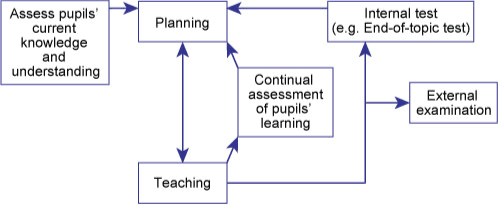2.1 Roles of assessment
More often than not, assessment in the past was done to students. Its main purpose was not to help improve learning; it was to find out what someone did – or did not – know. Learners were often simply given a mark or a brief comment (‘excellent’, ‘could do better’ and so on). Little help was given to learners regarding their particular difficulties or how they might improve their work. This is assessment of learning (AoL), which is also known as summative assessment.
The role of assessment in school today is thought about very differently – much emphasis is placed on assessment for learning (AfL, also known as formative assessment). Links between different types of assessment are summarised in Figure 1, and Table 1 distinguishes between AoL and AfL.
| Assessment of learning | Assessment for learning | |
|---|---|---|
| Purpose | To find out what students know, understand and can do (skills) | To find out what students know, understand and can do (skills) |
| Uses | Medium and long-term reporting to others (exam results) Judging school effectiveness Certification | Day to day and within sequences of lessons, assessment for and with students To inform planning (future learning objectives) To support students in making and monitoring progress (identify individual, evolving needs) To support teacher evaluation of the effectiveness of practice (check objectives against outcomes) |
| Audiences | Parents School External agencies (e.g. inspections) | Students Teacher |
An over-reliance on AoL – focusing on grades rather than where to go next – can damage the self-esteem of low attainers, while high attainers become reluctant to take risks due to fear of failure. AfL approaches seek to avoid these pitfalls. The importance of AfL and the crucial role that it plays in enhancing teaching and learning is supported by a great deal of research. It is important to ensure that assessment is the servant of teaching and learning and not their master.
Reflection point
Can summative assessment be used formatively?

